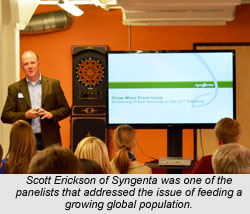Production Pressure: Feeding the World by 2050
 Although agriculture is a bright spot in the U.S. economy, it will face serious challenges in the next 40 years. Perhaps the greatest of these is population growth, which is why members of the North Central NAMA chapter met in November to get a clearer understanding of what it will take to keep the world fed through 2050.
Although agriculture is a bright spot in the U.S. economy, it will face serious challenges in the next 40 years. Perhaps the greatest of these is population growth, which is why members of the North Central NAMA chapter met in November to get a clearer understanding of what it will take to keep the world fed through 2050.
Paul West, Chief Collaboration Officer from Minnesota’s Institute on the Environment, provided a top-level overview of these challenges. He made three key points:
First, he said, agriculture needs to meet the current demands. There are seven billion people on the planet today, one billion of which are hungry. Second, agriculture must meet future demands, as the population is projected to skyrocket to nine billion by 2050. And lastly, agriculture must find a way to become truly sustainable.
To improve agriculture, to keep feeding the plant, and to save the environment, West offered five steps:
- Slow the expansion of agriculture
- Close yield gaps
- Close diet gaps
- Improve efficiency
- Reduce food waste
 West’s presentation was followed by Scott Erickson, Soybean Portfolio Manager at Syngenta. Providing a corporate view of agriculture, Erickson agreed that high water consumption and tackling efficiency are serious issues that need to be addressed. He noted that growers need to leverage the genetic potential of the field and focus on the technologies that will increase crop yields.
West’s presentation was followed by Scott Erickson, Soybean Portfolio Manager at Syngenta. Providing a corporate view of agriculture, Erickson agreed that high water consumption and tackling efficiency are serious issues that need to be addressed. He noted that growers need to leverage the genetic potential of the field and focus on the technologies that will increase crop yields.
Tina Charpentier, Director at Padilla Speer Beardsley, added a more consumer-focused perspective to the discussion. She noted that some of the image struggles agriculture is facing in the consumer environment is the result of unclear storytelling. All audiences – including consumers, employees, suppliers, legislators and regulators – need to be aware of how hard the agriculture industry is actually working to provide quality food while still preserving the environment, Charpentier said.
Later, in a question-and-answer session, each of the speakers dove deeper into the complex issues of the economic demand for food and the basic need for food – in particular, how sustainability and marketing messages can be focused to reach agriculture and consumer audiences alike.
Although farmers and consumers are sometimes different audiences, the speakers agreed, they do share a single goal: Keeping the world alive.
No comments.
No comments are allowed on this page.